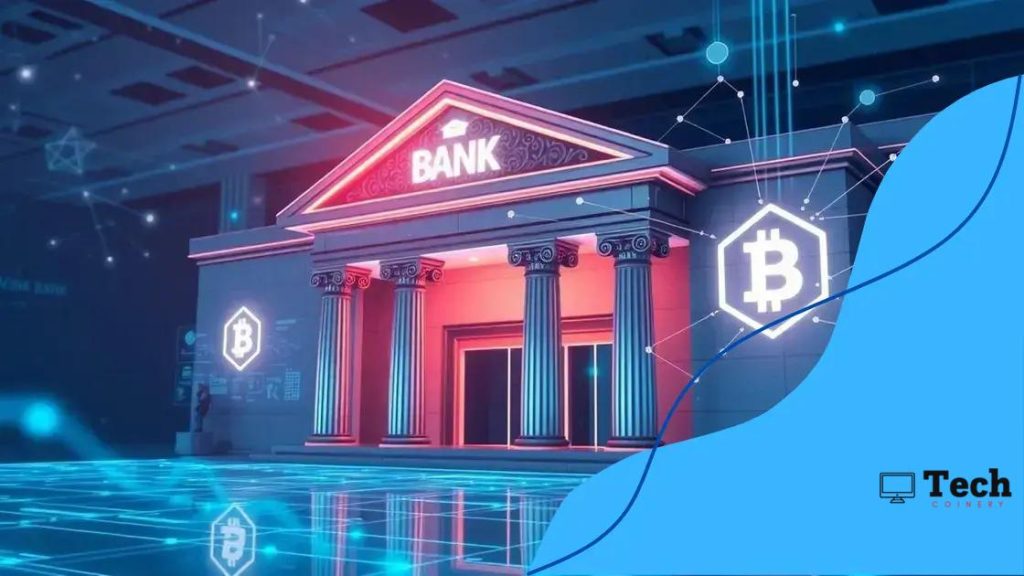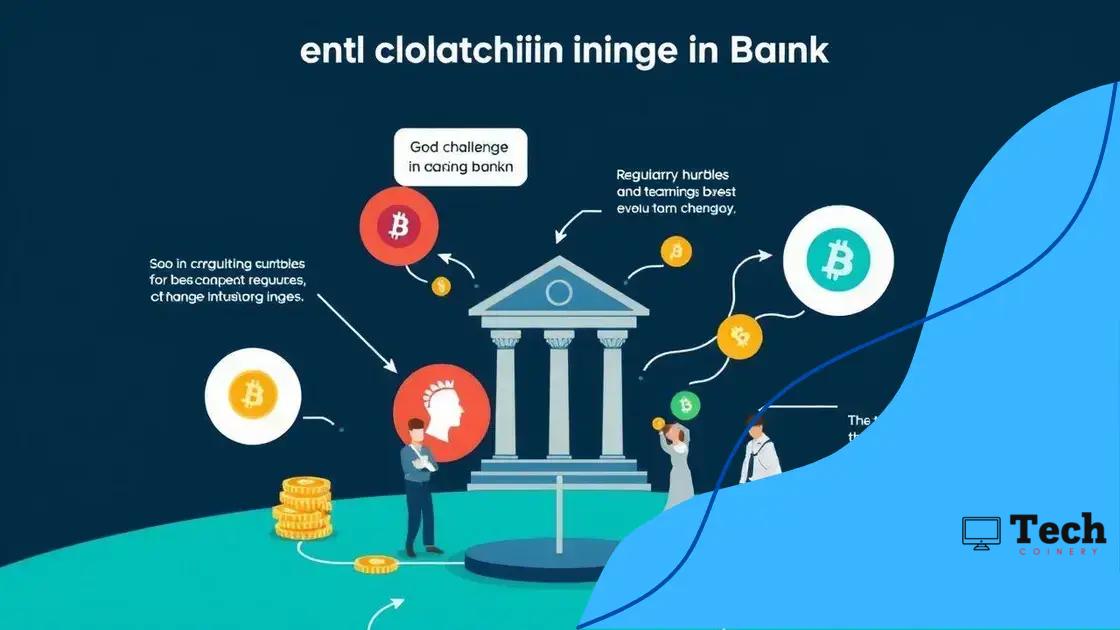Blockchain adoption in banking: what you need to know

Blockchain adoption in banking enhances transaction speeds, security, and transparency, while enabling decentralized finance (DeFi) and innovative solutions, ultimately transforming the financial landscape.
Blockchain adoption in banking is making waves in how financial institutions operate. Have you considered how this technology could reshape your banking experience? In this article, we’ll dive into its benefits and challenges.
Understanding blockchain technology
When we talk about blockchain technology, we are referring to an innovative system that securely records transactions. This technology is decentralized, meaning it eliminates the need for a central authority, making processes more efficient.
Blockchain works by creating a chain of blocks that hold information. Each block contains data, the hash of the previous block, and a timestamp. This structure ensures that once a block is added, it cannot be altered.
Key Features of Blockchain
There are several features that make blockchain particularly powerful:
- Transparency: Everyone can see the transaction history.
- Security: Data is encrypted and immutable.
- Decentralization: No single point of failure exists.
- Efficiency: Transactions are processed faster than traditional banking.
As we delve deeper into the mechanics of blockchain, it’s essential to understand how it affects industries, particularly banking. The ability to use blockchain can streamline operations by reducing costs and improving transaction speeds.
Moreover, one of the best aspects of blockchain is its ability to foster trust. Since the records are immutable and transparent, users feel secure engaging with this technology. This trust is crucial, especially in the financial sector.
Types of Blockchain
There are several types of blockchain, each serving unique purposes:
- Public Blockchains: Open for anyone to participate.
- Private Blockchains: Restricted access for specific users.
- Consortium Blockchains: Controlled by a group rather than a single entity.
Understanding these differences helps businesses choose the right type of blockchain for their needs, particularly for banking applications where security and efficiency are paramount.
In conclusion, blockchain technology is not just a passing trend; it’s a fundamental shift in how we think about transactions and data integrity.
Key benefits of blockchain in banking
The key benefits of blockchain in banking are transforming the financial industry. This technology introduces efficiency, security, and transparency to traditional banking processes.
One of the most important advantages is how blockchain enhances transaction speeds. With blockchain technology, transactions can occur in real-time, cutting down the waiting period significantly compared to conventional banking methods.
Advantages of Blockchain in Banking
Additionally, blockchain improves security through its decentralized nature. Here are some key advantages:
- Fraud reduction: The likelihood of fraud is minimized because of the immutable ledger.
- Cost reduction: By reducing intermediaries, banks can decrease transaction fees.
- Access to global markets: Blockchain opens doors for transactions across borders efficiently.
- Customer trust: Enhanced transparency leads to greater customer confidence.
Incorporating blockchain can streamline compliance and regulatory reporting. Banks can maintain a single, accurate record that is easily accessible by regulatory bodies. This not only saves time but also minimizes errors.
Another significant aspect is the ability to provide better customer experiences. With faster transactions and lower fees, banking becomes more user-friendly. Clients can easily access their accounts and perform transactions without the usual hurdles.
Long-term Benefits
Over time, the long-term benefits of adopting blockchain technology can change the landscape of the banking industry:
- Sustainability: Reduced energy consumption in transaction verification.
- Innovation: New financial products and services can emerge from blockchain integration.
- Risk management: Improved methods for assessing credit and evaluating borrowers.
These advantages show why many financial institutions are eager to adopt blockchain technology. Its potential to reshape banking is both promising and inevitable, paving the way for a more efficient future.
Challenges in adopting blockchain

While there are numerous benefits to adopting blockchain technology, several challenges also arise. Understanding these obstacles is crucial for financial institutions considering this transition.
One significant challenge is the regulatory uncertainty that surrounds blockchain. Legislators are still figuring out how to manage blockchain within existing laws, which can create confusion for banks looking to adopt this technology.
Common Challenges Faced
Additionally, the integration of blockchain into current banking systems presents technical difficulties. Here are some common challenges:
- Scalability: Blockchain networks may struggle to handle large volumes of transactions efficiently.
- Interoperability: Different blockchain protocols may not work well together, complicating the integration process.
- Cost of implementation: Setting up blockchain solutions can be expensive and resource-intensive.
- Skill shortage: There is a limited pool of professionals with expertise in blockchain technology.
These challenges can discourage banks from moving forward with blockchain adoption. Moreover, there is often a lack of understanding about how blockchain can be leveraged to address specific banking needs.
Another factor to consider is the need for cultural change within organizations. Employees may need training to adapt to new systems, which can take time and resources. Resistance to change is common, and this can slow down the adoption process.
Addressing the Challenges
Despite these challenges, the potential rewards of blockchain are substantial. Many organizations are actively seeking solutions to overcome these hurdles:
- Collaboration: Banks can partner with technology companies to share resources and knowledge.
- Innovation: Developing pilot projects can help address scalability and interoperability issues.
- Education: Training programs can help build a knowledgeable workforce that is comfortable with blockchain.
By addressing these challenges head-on, banks can unlock the full potential of blockchain technology and pave the way for a more efficient and secure banking future.
Real-world examples of blockchain use
There are many real-world examples of blockchain use that showcase how this technology is changing various industries, especially banking. Through practical applications, we can see the potential of blockchain in action.
One notable example is De Beers, a company that uses blockchain to track the diamonds from mines to consumers. This process ensures that the diamonds are ethically sourced and helps prevent fraud in the diamond trade.
More Real-World Applications
Another important case is Ripple, a digital payment protocol that facilitates fast and low-cost international transactions. Banks and financial institutions use Ripple’s technology to settle cross-border payments instantly.
- IBM Food Trust: This blockchain solution tracks food products in the supply chain, increasing transparency and safety.
- Ethereum: Many decentralized applications (dApps) run on Ethereum, offering services like lending, trading, and more.
- Chainalysis: A blockchain analysis platform that helps governments and banks track cryptocurrency transactions to prevent fraud.
The integration of blockchain into banking is also evidenced by projects such as the JPMorgan Coin, which aims to provide a digital payment solution for cross-border transactions. These initiatives highlight how banks leverage blockchain for greater efficiency.
Moreover, Sweden’s land registry has adopted blockchain for property transactions. This advancement simplifies the registration process and ensures secure ownership records.
Impact on Various Industries
The impact of blockchain goes beyond banking. Companies in healthcare, real estate, and supply chain management are exploring blockchain for transparency and security:
- Healthcare: Patient records can be securely stored on a blockchain, enhancing privacy.
- Real Estate: Smart contracts can automate property transfers, reducing legal costs.
- Supply Chain: Companies can trace products’ origins and ensure authenticity.
These examples demonstrate that whether in banking or other sectors, blockchain technology is paving the way for innovative solutions and increased trust among users.
The future of blockchain in finance
The future of blockchain in finance is bright and full of potential. As technology continues to evolve, financial institutions are increasingly looking to leverage its capabilities.
One promising aspect is the rise of decentralized finance, or DeFi. This innovation allows users to conduct financial transactions without traditional banks, opening new possibilities for accessibility and lower fees.
Emerging Trends to Watch
Another trend is the integration of smart contracts. These self-executing contracts can automate processes, reducing the need for intermediaries. Imagine a loan that automatically executes when certain conditions are met—this could revolutionize lending.
- Tokenization: Physical assets like real estate or art can be represented as digital tokens on a blockchain.
- Central Bank Digital Currencies (CBDCs): Many central banks are exploring digital currencies, which could reshape how we approach money.
- Enhanced Security: With the use of advanced cryptography, blockchain offers robust security against fraud and cyber threats.
As we look to the future, it’s clear that collaboration will be key. Financial institutions are likely to partner with tech firms to innovate and deploy solutions. This cooperative approach can lead to the development of new products and services tailored to consumer needs.
Moreover, regulations will continue to evolve in tandem with technology. Clear frameworks will help build trust and ensure compliance as blockchain moves into more mainstream applications.
The Impact on Consumer Experience
In addition to innovation, blockchain promises to improve the overall customer experience. With faster transaction times and lower fees, customers will enjoy a more streamlined banking experience:
- Instant payments: Transactions can be completed in real-time without delays.
- Greater transparency: Customers can track their transactions more easily.
- Increased access: Blockchain can provide financial services to unbanked populations worldwide.
As these developments unfold, the future of blockchain in finance will likely bring more efficiency and inclusivity to the financial sector. Staying ahead in this fast-paced environment will be essential for banks and financial institutions.
FAQ – Frequently Asked Questions about Blockchain in Finance
What are the main benefits of blockchain in finance?
The main benefits include faster transactions, enhanced security, lower fees, and greater transparency in financial operations.
How does blockchain improve security?
Blockchain uses advanced cryptography to secure transactions, making it difficult for unauthorized access or fraud to occur.
What is decentralized finance (DeFi)?
Decentralized finance (DeFi) allows users to conduct financial transactions outside of traditional banking systems, often resulting in lower costs and greater accessibility.
How can businesses prepare for adopting blockchain technology?
Businesses can prepare by fostering collaboration with tech firms, providing training for employees, and staying updated on regulatory changes related to blockchain.






